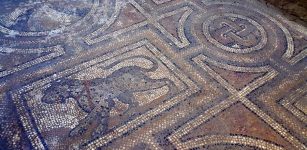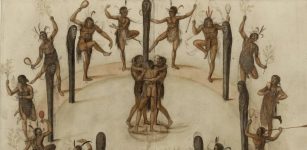Quest For The Magical Healing Flower In The Garden Of Bakavali Led To A Love Story
Ellen Lloyd - AncientPages.com - The description of the Garden of Bakavali can be found in Gul-e-Bakavali, one of the earliest Persian–Arabic and Hindustani stories collated by the British at the Fort William College in Calcutta at the turn of the nineteenth century.
The text mentions Gul, a flower that possesses extraordinary healing powers. It is believed to grow behind a legendary mountain called Kohi Kaff (today's Pamirs). Superhuman creatures and supernatural beings inhabit this region.
Magnificent Garden of Bakavali Was Not Easy To Find
Mythical gardens are always filled with the most beautiful trees, stunning flowers, and plants, and the Garden of Bakavali was a heavenly place.
The Garden of Bakavali was a magical place where one could find the most beautiful plants. Credit: Public Domain
"It is related that in the mythic Garden of Bakavali there grew trees of rubies with bunches of fruit so brilliant that they were equal to the clusters of stars which group themselves around the Tree of the Sun." 1
Like Greek nymphs guarded Hesperides, the fabled garden with divine apples of immortality, the Garden of Bakavali was also complicated to access. This was where magical plants grew, and the garden's location was kept secret, and only a few knew where it could be found.
Prince Taj-al-Maluke And The Quest For Gul, The Healing Flower
In the story, Zainal Maluke, a king of eastern lands, warns his astrologers to stay away from his son Taj-al-Maluke for 12 years because the young man is under a bad star. Unfortunately, the father sees his son and goes blind.
When Taj-al-Maluke is excommunicated for causing blindness to his royal father, he understands he must do something. He learns about a powerful flower that can restore sight and decides to go and search for it, but it is located in a garden that is almost impossible to reach.
Prince Taj-al-Maluke is a courageous young man who is not afraid of challenging obstacles. He travels to foreign lands where he encounters threatening creatures and dangers lurking wherever he goes. However, the young man is determined to find the flower to save his father. In some versions of the story, the prince learns about the healing flower from God Indra.
Like most heroes, Taj-al-Maluke is courageous, motivated, and unstoppable. As Amaresh Datta explains in the Encyclopaedia of Indian Literature, "his determination and single-mindedness in the face of all kinds of odds, natural as well as supernatural, is exceptional and most behaving of a typical hero. Even his cowardice and unscrupulous step-brothers conspire against him. Taj-al-Maluke not only outwits them but also saves rescues them from the bad situations."
It takes time, and the prince must overcome many dangers, but finally, he finds the mysterious Garden of Bavakali which is also home to a beautiful princess.
Prince Taj-al-Maluke had to find the magical flower to restore his father's eyesight. Credit: Public Domain
"Taj break into the Garden of Bakavali, steals the flower but loses his heart to the sleeping beauty Bakavali. The next morning Bakavali wakes to find to her utter disbelief her favorite flower gone and a golden ring on her finger. She pledges to avenge the theft. But in the process falls in love with Taj, gets betrothed to him, her parents punish her and turn her into stone. Taj-al-Maluke liberates her. But her woes do not end here. She is burnt alive, is born again in a poor family and gets married to Taj." 2
The story of the Garden of Bakavali and prince Tal-al-Maluke's quest for the magical flower Gul is a love story that is well-known throughout Asia, and there are various versions of this myth.
Updated on February 14, 2022
Written by Ellen Lloyd – AncientPages.com
Copyright © AncientPages.com All rights reserved. This material may not be published, broadcast, rewritten or redistributed in whole or part without the express written permission of AncientPages.com
Expand for references1. Alexander Porteous - The Forest in Folklore and Mythology
2. Amaresh Datta - Encyclopaedia of Indian Literature
More From Ancient Pages
-
 Mystery Of 2000-Year-Old Basel Papyrus Likely Written By Physician Galen – Is Solved
Archaeology | Jul 14, 2018
Mystery Of 2000-Year-Old Basel Papyrus Likely Written By Physician Galen – Is Solved
Archaeology | Jul 14, 2018 -
 Secrets Of The Serpent Kingdom Revealed On Maya ‘Game Of Thrones’ Altar
Archaeology | Sep 15, 2018
Secrets Of The Serpent Kingdom Revealed On Maya ‘Game Of Thrones’ Altar
Archaeology | Sep 15, 2018 -
 Antediluvian Time-Capsule Hidden In Forbidden Ancient Egyptian Crypts?
Ancient Mysteries | May 7, 2018
Antediluvian Time-Capsule Hidden In Forbidden Ancient Egyptian Crypts?
Ancient Mysteries | May 7, 2018 -
 Ancient Byblos: Powerful Phoenician City With Own Kings
Civilizations | Apr 23, 2016
Ancient Byblos: Powerful Phoenician City With Own Kings
Civilizations | Apr 23, 2016 -
 Ruins Of A Roman-Era Bath And A Floor Mosaic Discovered In Central Anatolia
Archaeology | Dec 28, 2015
Ruins Of A Roman-Era Bath And A Floor Mosaic Discovered In Central Anatolia
Archaeology | Dec 28, 2015 -
 On This Day In History: The Battle of Blore Heath – Sep 23, 1459
News | Sep 23, 2015
On This Day In History: The Battle of Blore Heath – Sep 23, 1459
News | Sep 23, 2015 -
 Mysterious Sumerian Star Tablet And Strange Divine Omens – Sacred Knowledge Of The Gods – Part 1
Ancient Mysteries | Feb 14, 2021
Mysterious Sumerian Star Tablet And Strange Divine Omens – Sacred Knowledge Of The Gods – Part 1
Ancient Mysteries | Feb 14, 2021 -
 Unexplained Forest Mystery In Oregon Baffles Scientists
Featured Stories | Jun 24, 2024
Unexplained Forest Mystery In Oregon Baffles Scientists
Featured Stories | Jun 24, 2024 -
 Why Did Sages And Shamans Repeatedly Visit The Mysterious Finnish Pirunkirkko Cave (Devil’s Church)?
Archaeology | Nov 27, 2023
Why Did Sages And Shamans Repeatedly Visit The Mysterious Finnish Pirunkirkko Cave (Devil’s Church)?
Archaeology | Nov 27, 2023 -
 Rare Gold Foils Found In Ancient Egyptian Tombs At Tel El-Deir In New Damietta
Archaeology | Jul 24, 2024
Rare Gold Foils Found In Ancient Egyptian Tombs At Tel El-Deir In New Damietta
Archaeology | Jul 24, 2024 -
 On This Day In History: Attila The Hun Captures The City of Metz – On Apr 7, 451
News | Apr 7, 2017
On This Day In History: Attila The Hun Captures The City of Metz – On Apr 7, 451
News | Apr 7, 2017 -
 35 Secret Underground Passageways Discovered Beneath Chavín De Huántar Temple Complex In Peru
Archaeology | Jun 1, 2022
35 Secret Underground Passageways Discovered Beneath Chavín De Huántar Temple Complex In Peru
Archaeology | Jun 1, 2022 -
 3D Scans Reveal Secrets Of Rare Ancient Canoe From Lake Mendota In Wisconsin
Archaeology | Jun 3, 2022
3D Scans Reveal Secrets Of Rare Ancient Canoe From Lake Mendota In Wisconsin
Archaeology | Jun 3, 2022 -
 The Burnt City And Its Mysterious Prehistoric Inhabitants
Civilizations | Nov 17, 2014
The Burnt City And Its Mysterious Prehistoric Inhabitants
Civilizations | Nov 17, 2014 -
 New Clues Why Neanderthals Visited La Cotte de St Brelade In Jersey 250,000 Years Ago
Archaeology | Jun 18, 2023
New Clues Why Neanderthals Visited La Cotte de St Brelade In Jersey 250,000 Years Ago
Archaeology | Jun 18, 2023 -
 Archaeologists Have A Lot Of Dates Wrong For North American Indigenous History
Archaeology | May 4, 2020
Archaeologists Have A Lot Of Dates Wrong For North American Indigenous History
Archaeology | May 4, 2020 -
 Rare 2,500-Year-Old Saw Discovered At The Ancient Hittite City Hattusa
Archaeology | Nov 27, 2023
Rare 2,500-Year-Old Saw Discovered At The Ancient Hittite City Hattusa
Archaeology | Nov 27, 2023 -
 Baby God Hermes Started His Life As A Liar And Trickster
Featured Stories | Dec 25, 2020
Baby God Hermes Started His Life As A Liar And Trickster
Featured Stories | Dec 25, 2020 -
 Voice Belonging To 3,000-Year-Old Egyptian Mummified Priest – Recreated
Archaeology | Jan 28, 2020
Voice Belonging To 3,000-Year-Old Egyptian Mummified Priest – Recreated
Archaeology | Jan 28, 2020 -
 Clan MacGregor: Fearless, Lawless And Persecuted Clan Of The Highlands
Featured Stories | Jul 9, 2018
Clan MacGregor: Fearless, Lawless And Persecuted Clan Of The Highlands
Featured Stories | Jul 9, 2018


